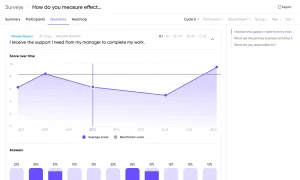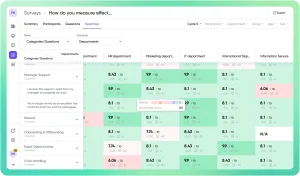Ambitious goals and exciting projects are incredibly inspiring. However, sometimes along with the drive comes a shadow side — employee overload.
It often goes unnoticed: teams work with full dedication, deliver impressive results, and take on new tasks. But over time, someone starts getting sick more often, fatigue appears in their eyes, and engagement drops. Suddenly, the company faces unexpected costs, key people leave, or productivity declines.
The good news is that overload can be prevented. It’s just a matter of recognizing the signals in time and acting without delay. In this article, Sereda.ai, together with Yaware, explains how to spot the problem early and turn risks into growth opportunities.
The Cost of Employee Overload
When we talk about overload, it’s not just about employees’ wellbeing. It directly affects business performance.
According to Gallup, employees who are burned out are twice as likely to look for another job, and their productivity decreases by an average of 63% compared to their peers.
Additionally, several other important factors should be considered:
Financial costs: Replacing one specialist can cost from 50% to 200% of their annual salary, depending on the position and experience level.
Risk of losing expertise: When people leave, their experience, knowledge of internal processes, and undocumented “tribal knowledge” leave with them.
Impact on culture: A chronically tired team generates fewer ideas, becomes less adaptable to change, and is more prone to conflicts.
The biggest loss, however, is trust. When people see that their health and energy are not a priority, enthusiasm quickly fades. And restoring it is far harder than preserving it.
Key Signs of Overload
It’s important not to wait until the situation reaches extremes. Overload almost always starts quietly and gradually. Here are the most common signals to watch for, especially if they become regular or intensify over time:
Decreased energy: People look exhausted even after weekends or vacations. They struggle to “switch on” in the morning and often appear tired or drained at the start of the week.
Less initiative: Employees who usually contribute ideas or participate in discussions become passive. In team meetings, they remain silent or refuse new tasks, even if it used to be normal for them.
More mistakes: Reduced focus leads even the most reliable employees to make more errors, both minor and critical. Deadlines are missed, and projects drag on without obvious reasons.
Behavioral changes: Irritability, sharp comments, or emotional instability may appear. Sometimes the opposite occurs — a person becomes withdrawn, avoids conversations, or seems “detached.”
Social distancing: Employees participate less in team events, cancel meetings, or interact less with colleagues even in work chats. Disappearing from the radar is always a reason to start a dialogue.
Cynical remarks: Comments like “Why bother? Nothing will change” or “It’s just work, I’ll do my hours” signal a loss of meaning and engagement.
Changes in personal habits: Some start working nights, others frequently fall ill or take short sick leaves. These changes often go unnoticed but can signal the start of burnout.
These signs align with data from the American Psychological Association (APA), which notes that early burnout manifests not only as emotional exhaustion but also as behavioral changes, altered communication, and a sharp drop in job satisfaction.
Where to Look for Overload Signals
Overload can be hidden and go unnoticed for a long time. That’s why the best approach is to combine observation with objective data. There are two main sources that provide a more complete picture:
Tracking Work Hours and Load
Numbers can speak louder than words. In work, they can become a beacon indicating where overload is brewing. Yaware, a time management product, highlights the key metrics to monitor first:
Active work time vs. total work time: Formally, a person is “online” for eight hours, but actually works focused for only three to four? This may signal exhaustion or inability to maintain pace.
Uneven workload: Every team has “locomotives” — those carrying most of the tasks. They are at the highest risk of burnout. If 20% of people do 80% of the work, it’s a warning sign to review task distribution.
Frequency of overtime: Sometimes extra effort is required. But if overtime becomes the norm, it’s time to reconsider resource planning and priorities.
Today, insights like these are easy to obtain — time-tracking systems, task-manager analytics, or productivity platforms like Yaware provide an accurate view of team load. This helps not only spot problems but also plan work more realistically.
Employee Surveys as an Emotional Barometer
Even the most accurate graphs won’t reveal the main thing — how people feel. Regular surveys are essential. Not long, check-the-box forms, but short and meaningful pulse surveys.
Sereda Surveys, a solution for measuring and optimizing employee engagement, identifies four key questions to anticipate burnout:
Do you have enough resources to complete your tasks?
What currently causes you the most stress?
Do you have time to recover between projects?
How would you rate your engagement over the past two weeks?
The idea is simple: constantly measure the “temperature” of the team. If last month engagement was 80%, and now it drops to 65% — it’s time to investigate.
Anonymity matters. People are more honest when they know answers won’t cause problems. Also, always share survey results and action plans. This builds trust and shows that data is collected for real change, not just “for show.”

What to Do After Identifying Risks
Identifying overload signals is only half the battle. True value comes when data turns into action. Key principles: don’t wait for perfect conditions to make changes. Here’s what to do after spotting warning signs:
Check Operational Load
Analyze workload at the process and role level:
Review priorities: Are all active initiatives truly critical now? Often overload comes not from volume but from scattered focus.
Assess roles and responsibilities: Are tasks concentrated in certain people or bottlenecks? Rebalance if needed.
Check resource planning: If the team constantly works overtime, it signals chronic resource deficits or poor planning. Adjust workloads or bring in extra help.
Tool: Capacity planning aligns available human resources with planned tasks, preventing systemic overload.
Develop Response Scenarios
Turn data into action plans so decisions aren’t made haphazardly:
Short-term: Immediate relief — adjust deadlines, delegate tasks, reduce low-priority initiatives.
Medium-term (1–3 months): Process review, automate routine tasks, train managers in load management.
Long-term prevention: Embed into culture and systems — regular workload audits, clear communication norms, transparency in expectations.
Communicate with Management
Overload usually cannot be solved locally in HR or People teams. It requires top management involvement:
Present data quantitatively: overtime frequency, stress indices, engagement drops, productivity impact.
Explain business consequences: turnover, knowledge loss, financial risks. This moves the problem from emotional to strategic.
Offer solution options with predicted business impact. Clear proposals make it easier for top management to decide.
Strengthen Managerial Skills
Data often shows symptoms, but the real cause is management style:
Can managers talk to people about workload?
Can they prioritize tasks?
Do they notice who carries too much?
If not, invest in managerial training — not just “training for training’s sake,” but focused on:
Developing capacity planning skills
Practicing delegation scenarios
Learning to handle workload conversations without conflict
Developing emotional intelligence to read team state in time
Use Real-Time Data
Overload is dynamic. Annual analysis misses opportunities for timely intervention. Best practice: live monitoring:
Automated dashboards with engagement, stress, and overtime metrics
Short, frequent surveys instead of long annual forms
Integrating HR data into overall OKR/KPI systems
This allows fast, targeted responses rather than large-scale crisis management after burnout has occurred.

How to Overcome Team Overload and Build a Culture of Trust
Overload is not a sentence. It’s a manageable risk zone if addressed consciously.
Companies that carefully manage employee resources not only reduce burnout risks but also create a culture of trust where people want to stay, grow, and contribute their energy and ideas to shared success.
Remember: caring for your team is an investment in business stability, innovation, and future. The earlier we address it, the fewer surprises we’ll face on the way to ambitious goals.

